 SILVER STARS SET FOREVER SILVER STARS SET FOREVER
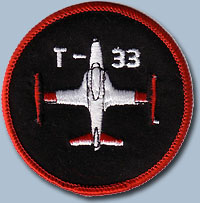
CANADIAN CT-133 T-BIRDS WITHDRAWN
Story/pictures : Stefan DEGRAEF / Edwin BORREMANS
On 12/04/2005 history was written in the Canadian ‘blue’ over Cold Lake (Alberta). Having ‘served’ with the Canadian Armed Forces for more then half a century, the final Canadair-built Lockheed CT-133 T-Bird jet-aircraft left ColdLake for ground-storage at CFB MountainView. The withdrawal of these T-Bird’s (aka. SilverStars in Canadian air force ‘slang’) marked a final end of the operational carreer of these aircraft, having entered operational service in 1953 as RCAF (Royal Canadian Air Force)’s main jet-trainer and trained countless generations of Canadian pilots. Later on replaced by Canada-built Tutor side-by-side trainers in the initial jet pilot training role, these “immortal” CT-133’s were far from redundant, offering pristine services for decades in a wide variety of supporting missions (liaison, electronic warfare, target towing and –surprisingly- adversary aircraft).
The final unit to operate the Canadair CT-133 T-Birds was the CFB ColdLake-based Aerospace Engineering Test Establishment (AETE), being Canada’s Flight Test Centre, using four aircraft for training and test-purposes, including the ‘live’-testing of ejection-seats and personal flight safety equipment. Surprisingly the ultimate decision to withdraw the (still very capable) AETE CT-133’s was not triggered by technical, maintenance or performance-related considerations but caused by the Canadian Departement of Defence’s (DND) neverceasing cost-cutting reforms and budget-reallocations (esp.development of UAV’s). The general condition of the airframes, the vast stocks of available spare-parts and –more importantly- their low operating cost and some of the unique testing features of these aircraft may see the future outsourcing of AETE’s test CT-133’s.
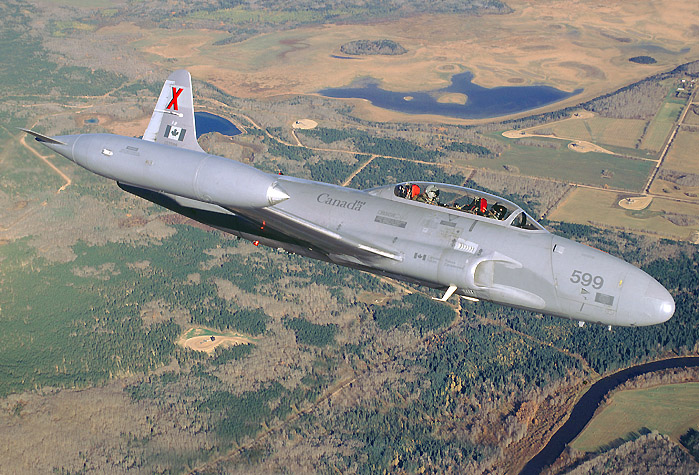
EJECTION SEATS : A NEVERENDING CHALLENGE
For more then half a decade, aircraft mounted ejection-seats have saved countless numbers of pilots and aircrew all over the world. Pulling or squeezing the firing-rings of these seats almost immedi ately trigger an irreversible (but much-welcomed) chain-of-events. Within the twinkling of an eye the crewmember in distress will be rocketed out the cockpit of the stricken aircraft. Within seconds –and well safe of the aircraft- he/she will be safely separated from the seat and once his/her parachute-canopy fully unfolded the forces of gravity will guide the pilot down to earth, enabling him/her to live another day and to exchange these (hopefully) ‘once in a lifetime’ experiences with colleagues and their families. ately trigger an irreversible (but much-welcomed) chain-of-events. Within the twinkling of an eye the crewmember in distress will be rocketed out the cockpit of the stricken aircraft. Within seconds –and well safe of the aircraft- he/she will be safely separated from the seat and once his/her parachute-canopy fully unfolded the forces of gravity will guide the pilot down to earth, enabling him/her to live another day and to exchange these (hopefully) ‘once in a lifetime’ experiences with colleagues and their families.
Although a lot has changed since the introduction of the first ejection seats in the mid-forties of the 20° century and the WorldWar II Luftwaffe’s Heinkel He219 ‘Uhu’ ejection seats are a far cry from the Y2K-era, sophisticated and ‘performance’-optimised seats of the new ‘fourth generation fighters’, the technical basics and limitations remain a timeless challenge for civil and military designers and manufacturers of ejection seats and other aeronautical survival equipment.
Struck by never ceasing changes in technical ejection-seat and pilot specifications (f.i. increasing human body-dimensions and female pilots), the development and operational introduction of survival equipment (ejection seats, personal safety harness…) is more then ever a high-tech and in-depth analysed and well-tested process. Due to its dedicated ‘life-saving’ ambition, all survival equipment needs to be ‘quality’-controlled, air-tested, validated and certificated ‘suitable for operational use’. By far the most important part in this long and demanding validation process is the ‘live’ (air-)testing of the various equipment-elements during simulated ejections. One of the few remaining 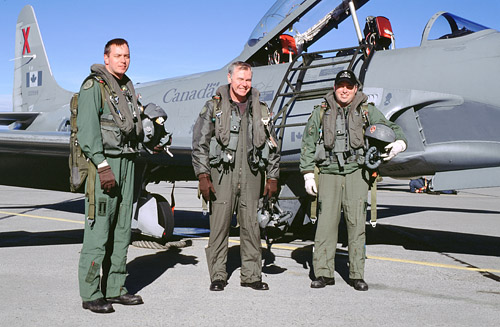 test-centres, having gained extensive experience in and well-equipped for air-testing of aeronautical survival equipments, is Canada’s Aerospace Engineering Test Establishment (AETE) at CFB Cold Lake (Alberta). This test centre housed –until 31/03/2005- Canada’s four remaining Lockheed-designed Canadair CT-133 T-Bird aircraft. One of these T-Birds was specially equipped for in-flight ‘live’ simulations of pilot-ejections, offering AETE an almost worldwidely unrivalled capability to test its survival equipment in realistic conditions. test-centres, having gained extensive experience in and well-equipped for air-testing of aeronautical survival equipments, is Canada’s Aerospace Engineering Test Establishment (AETE) at CFB Cold Lake (Alberta). This test centre housed –until 31/03/2005- Canada’s four remaining Lockheed-designed Canadair CT-133 T-Bird aircraft. One of these T-Birds was specially equipped for in-flight ‘live’ simulations of pilot-ejections, offering AETE an almost worldwidely unrivalled capability to test its survival equipment in realistic conditions.
AETE : CANADA’s AERONAUTICAL THINKTANK
Established in 1971 by amalgating various smaller evaluation establishments, AETE’s mission is to provide cost-effective, timely, quality engineering evaluations of the airworthiness and operational effectiveness of the air force’s aerospace systems. By becoming the exclusive flight test agency of the Canadian Armed Forces, the Establishment conducts a wide variety of flight and ground testing involving every aircraft and helicopter type in the Canadian inventory. Furthermore AETE is also responsible for the evaluation of all new systems to be installed on and air-launched weapons used by all Canadian military aircraft and helicopters.
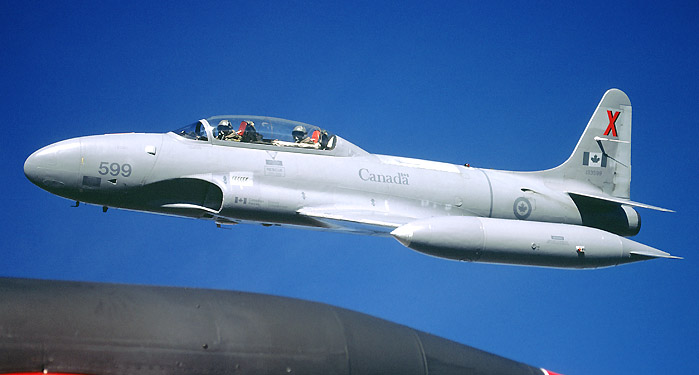
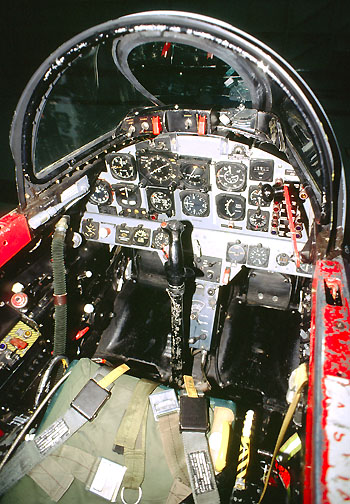
Based at CFB ColdLake (Alberta), homebase of No.4 Wing and its three dependent McDonnellDouglas/Boeing CF-188 Hornet squadrons, AETE uses the vast almost unlimited aerospace around ColdLake for flight test operations. The Cold Lake Air Weapons Range (CLAWR) contains the well-equipped Primrose Lake Evaluation Range (PLER), being AETE’s primary test range.
For evaluation and testing purposes, three drop zones for air-launched weapons are available, all ‘guarded’ by advanced photo- and video-theodolites for data-collection, recording and transmitting. All telemetric data are transmitted in real-time to the Flight Test Control Room in the AETE-installations at ColdLake.
In order to conduct its ground and in-flight test work, AETE is staffed by some 230 military and civilian personnel with a wide variety of scientific skills and knowledge. The unit’s pilots, originating from Canada’s fighter, transport- and helicopter community, will have all attended one of the four recognized test pilots schools : the Empire Test Pilots School (ETPS) at Boscombe Down, the Air Force Flight Test Center (AFFTC) at Edwards AB, the Naval Test Pilot School (NTPS) at NAS Patuxent River or the Ecole du Personnel Navigant d’Essais et de Reception (EPNER) at Istres. Similar to other test-units, AETE’s uses a wide variety of specially equipped and instrumented fixed-wing (jet) aircraft and helicopters, ranging from modified CF-188 Hornet fighter aircraft to CH-146 Griffon-helicopters. Both types are modified with modern digital data collection systems, providing an accurate data and test-parameters to the test-crew. In addition AETE’s uses unmodified CT-144 Tutors and Canada’s final Canadair CT-133 T-Birds for photo-chase and training purposes.
One of the most important –but low-key- AETE-operations is the evaluation, prototype development and testing of Escape Systems and Aircrew Life Support Equipment. For (air) testing of ejection seats, AETE used some ‘home-made’ hardware, incl. a specially modified CT-133 T-Bird, giving the Establishment some unrivalled testing capabilities.
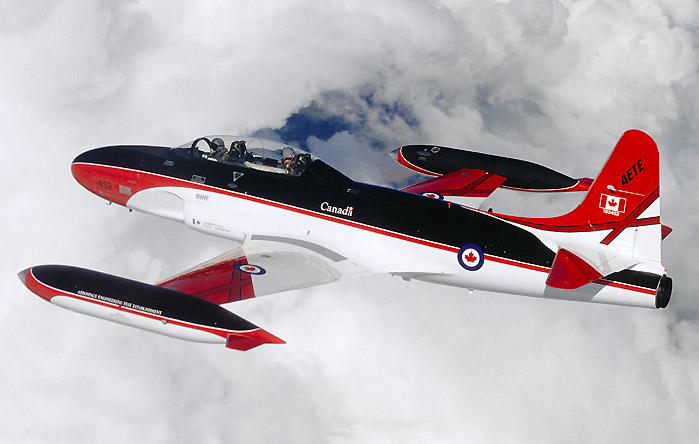
AETE’s T-BIRD : FOREVER YOUNG
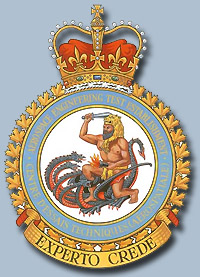
On 31/03/2002 the Canadian Forces finally withdrew its final 28 CT-133 Silver Stars (aka T-Birds) from operational service, after an ‘illustrious’ career of almost half a century with almost all Canadian fixed-wing jet squadrons. Two ‘Combat Support’ squadrons –No.414 at CFB Comox (British Colombia) and No.434 at CFB Greenwood (NovaScotia)-, using the ‘old’ T-Birds for multiple support taskings for the Canadian air force and navy, were disbanded. The two remaining units, No.417(CS) at CFB ColdLake (Alberta) and No.439(CS) at CFB Bagotville (Quebec), remained operational being also equipped with CH-146 Griffon helicopters. All remaining CT-133’s, some of them being updated under the AUP-update (Avionics Update Programme) only a few years earlier, were flown to CFB MountainView (Trenton/Ontario) for storage pending final decision regarding their future.
The withdrawal of the ‘multirole’ and ‘cheap to operate’ CT-133’s deprived the Canadian Forces of a much-welcomed and –needed training-asset since these aircraft were frequently used as (electronic warfare) aggressor-aircraft during air and naval exercises and as target-towing aircraft for naval-gunnery training. Several ex-CF CT-133 T-Birds were sold to civilian companies, preparing after de-militarisation and civil certification of the US-registrated aircraft to tender for Canadian DND support contracts. All civil-contracted jet-aircraft operated by civil contractors are flown by ex-CF fighter pilots, still familiar with prevailing military flying and operational procedures. At least 14 AUP-modified CT-133 were sold to Air Combat Warfare International at Kitchener (Ontario).
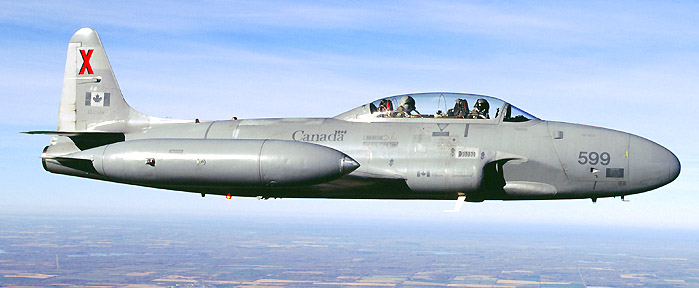
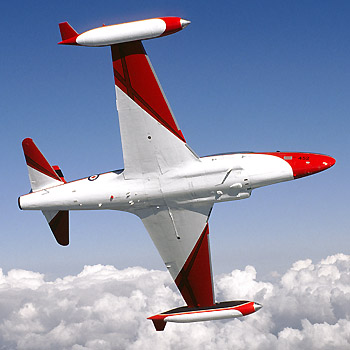
Four of the withdrawn CT-133’s, all modified with upgraded cockpits, were transferred to the AETE at ColdLake. For many years, this Establishment used the ‘venerable’ T-Bird for various test-supporting tasks, sometimes necessitating airframe and internal modifications to the aircraft’s airframe. Although T-Birds of the co-located No.417CS squadron became redundant and available for AETE-use, after the official withdrawal of the CT-133 in CF-service and structural inspections of all available aircraft, the four ‘new’ T-Birds are originating from almost all former CT-133 units. In addition two CT-133’s (s/n 133546 and 133656) were kept in flyable preservation at CFB Mountain View as attrition replacement aircraft. Once a week the engines of these ‘133’s were fired up by personnel of the MountainView-based Aerospace & Telecommunications Engineering Support Squadron (ATESS).
The influx of the ‘new’ aircraft enabled AETE to withdraw its ‘old’ CT-133’s including the specially modified ‘133613’ and ‘133413’, being stored at ColdLake. Still wearing its ‘traditional’ natural finish and an extra-long red/white pitot tube, CT-133 ‘133613’ was used to monitor various structural loads on the airframe and pitot-static calibration. In 2002 the aircraft was sold to an US-based warbird-collector, only to leave ColdLake for the United States in August 2004. The other ‘purpose-modified’ CT-133 –133413- was used an ejection-seat testbed. Late 2002, withdrawn from operational testing-use and stored at ColdLake, it’s final faith was not clear. Efforts were made to preserve this (almost) unique aircraft in the local « ColdLake Museum » and to prevent it to be scrapped at CFB ColdLake.
Having been stored outside AETE’s main hangar for several years, standard photo-chase CT-133 '572' will be used for recovery (i.e. post-crash) training on the ground stripped of all instruments. Finally, the specially marked CT-133 ‘133542’ will remain stored at ColdLake pending preservation in front of AETE’s operations building.

Prior to their withdrawal the three general-purpose CT-133 aircraft were used for a wide variety of test-supporting and training missions. Currently six AETE-pilots are qualified on the T-Bird, only one being backseat-qualified. Similar to other test establishments, all AETE-pilots are qualified on two aircraft-types with the CT-133 being the most straightforward candidate as a second fixed-wing qualification. Together with AETE CT-114 Tutors, the CT-133’s were used for photo-chase missions during the various air-tests with the various AETE-aircraft. During these missions, flown over the Primrose Lake Evaluation Range (PLER), a qualified chase pilot and a specially trained image system technician were flying the CT-133. On general a 100 feet lateral separation was flown, enabling the high-speed film cameras in the tip tank and ‘handheld’ by the backseater to capture all testing-events on film.
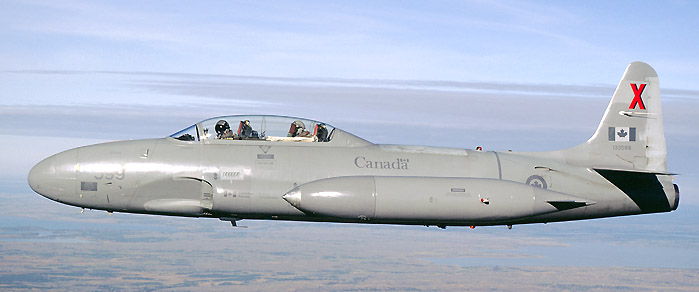
Finally these ‘fifties-built’ T-Birds were also used to screen operational fighter and fixed-wing pilots applying for test-pilot training. Requiring four new test-pilots to be trained every year, AETE-candidates are ‘submitted’ to a low-key test-simulation and screening. During two weeks these pilots would fly the CT-133 (or CT-114 Tutor) in a simulated test-environment enabling qualified AETE-‘instructors’ to monitor the test-capabilities of the candidates, prior to their eventual selection and test-pilot training in the United States (NTPS/AFFTC) or Europe (ETPS/EPNER). In addition the CT-133s were also used to get (and keep) transport-origin pilots familiar with jet-aircraft.
All first level maintenance and component replacement, using the vast stocks of ‘basic’ spare-parts, was done by AETE-personnel at CFB ColdLake. For regular first and second level inspections, the aircraft were flown to No.8 Wing at CFB Trenton.
In anticipation of the final withdrawal of its T-Bird ejection-seat testbed, AETE’s staff started a technical feasibility study to convert one of the Canadian Armed Forces CF-188B Hornet trainers into a new more capable ejection-testbed, allowing high altitude and –speed (above 600 knots) ejection-simulations.
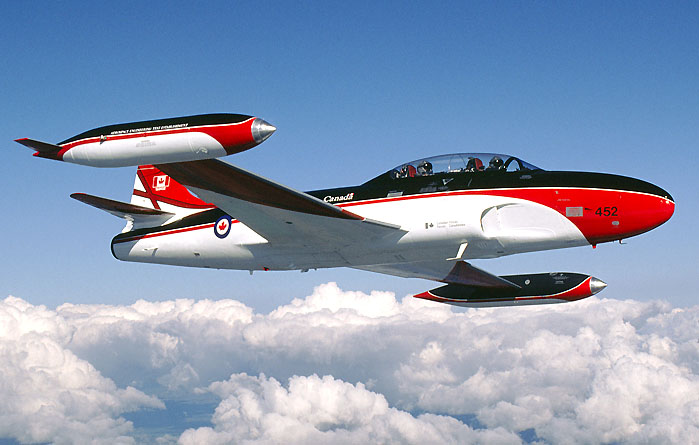
From November 2004 on, the AETE’s four remaining CT-133’s were gradually withdrawn and replaced by additional CT-144 Tutor aircraft. These three ‘new’ unmodified Tutor-trainer were obtained from a pool of aircraft, becoming redundant after the withdrawal of the Tutor-trainers at CFB MooseJaw and their replacement by the far more modern Raytheon T-6A Harvard II tandem-propeller trainers, operated by the multinational NFTC-consortium. The arrival of these new Tutors enabled AETE to re-evaluate its Tutor-‘population’ and to withdraw some of their ‘high houred’ airframes, keeping five aircraft airworthy at all times.
EJECTION SEAT TESTING : BLACK THUNDER & T-BIRD
AETE’s almost unique developments in escape systems testing has attracted international attention and admiration. An increasing shortage of suitable, efficient and low-cost ejection seat testing hardware triggered AETE’s development of some world-class ‘home-made’ ground and airborne test-platforms for ejection seat and survival equipment testing.

For ground and low-speed testing of (all sort of) ejection seats, AETE’s uses a locally modified Dodge RAM 3500 Series V10 pick-up truck, pampered nicknamed « BlackThunder ». Fitted with a flatbed, extra external fire extinguishers, up to five high speed cameras and a control panel in the cabin, this Dodge –officially known as ‘Ejection Seat Ground Test Vehicle’- fires test-seats up to 60 indicated air speed using ColdLake’s outer runway. Costing around 100.000 $ per firing, these ground firings are cost-benefit effective alternatives to more expensive airborne trials. During the recent Tutor and T-Bird ejection seat modification programmes, on average six BlackThunder-ejections were incorporated in the programme.
Airborne testing of ejection seats and impact of the ejection-process on the pilot is done by using AETE’s most remarkable asset : a specially modified CT-133 T-Bird (sn. 133648). Ejection seats to be tested were bolted to special aluminium ‘bathtub’ in the backseat of the aircraft. Slightly inclinated (12°), seats were fired, electrically ejected through a specially developed half-open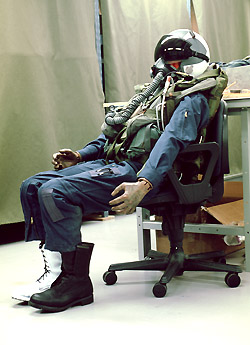 canopy by the pilot from the frontseat, from 125 knots up to 450 knots with ‘G’-forces ranging from –1G to +4G pending test-requirements and objectives. The ‘backseat’ was mechanically armed prior to take-off but electrically isolated until the actual firing, using a series of switches opening the isolated circuit and initiating the firing. To protect the pilot ‘in command’ a blast shield was mounted between the cockpits, isolating the backseat. Additional modification are the removal of all flight controls from the backseat-cockpit, addition of firing circuits in the front cockpit and fortification of the base of the vertical fin to avoid damage from the ejection-seat exhaust. Onboard-cameras could be mounted in the empty tiptanks. To avoid unwanted interference with the seat/dummy movement during the ejection and seat-separation process and with the photo-tracking crew, the CT-133 pilot initiated a climb or dive immediately after the ej canopy by the pilot from the frontseat, from 125 knots up to 450 knots with ‘G’-forces ranging from –1G to +4G pending test-requirements and objectives. The ‘backseat’ was mechanically armed prior to take-off but electrically isolated until the actual firing, using a series of switches opening the isolated circuit and initiating the firing. To protect the pilot ‘in command’ a blast shield was mounted between the cockpits, isolating the backseat. Additional modification are the removal of all flight controls from the backseat-cockpit, addition of firing circuits in the front cockpit and fortification of the base of the vertical fin to avoid damage from the ejection-seat exhaust. Onboard-cameras could be mounted in the empty tiptanks. To avoid unwanted interference with the seat/dummy movement during the ejection and seat-separation process and with the photo-tracking crew, the CT-133 pilot initiated a climb or dive immediately after the ej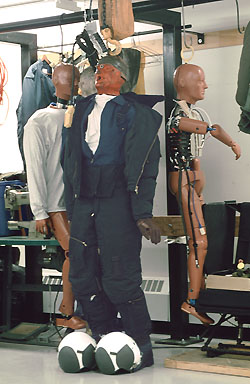 ection before returning to CFB ColdLake. Photo- and video-tracking was done by image systems technicians flying in the chase-aircraft (CT-114 Tutor or CT-133 T-Bird) or on the ground using fixed video-theodolites, positioned around the test-area. Sometimes AETE’s CH-146 Griffon-helicopters were used for photo/video collection, esp. filming seat-separation and parachute opening. Since no radar-deflector was mounted on the ejection seat and/or dummy-pilot, all tracking and videoing was done by manual tracking, demanding high skill- and experience-levels by all personnel involved. On average, depending on the type of test-programme, an average of ten seats every year have been fired using the T-Bird platform. Since 1995, second generation seats from CT-114 Tutor, CT-133 T-Bird and the US Navy Aircraft Common Ejection Seats (NACES) have been air-tested by AETE’s CT-133 T-Bird. ection before returning to CFB ColdLake. Photo- and video-tracking was done by image systems technicians flying in the chase-aircraft (CT-114 Tutor or CT-133 T-Bird) or on the ground using fixed video-theodolites, positioned around the test-area. Sometimes AETE’s CH-146 Griffon-helicopters were used for photo/video collection, esp. filming seat-separation and parachute opening. Since no radar-deflector was mounted on the ejection seat and/or dummy-pilot, all tracking and videoing was done by manual tracking, demanding high skill- and experience-levels by all personnel involved. On average, depending on the type of test-programme, an average of ten seats every year have been fired using the T-Bird platform. Since 1995, second generation seats from CT-114 Tutor, CT-133 T-Bird and the US Navy Aircraft Common Ejection Seats (NACES) have been air-tested by AETE’s CT-133 T-Bird.
In October 1999 all Canadian CT-133s, including AETE’s test aircraft, were grounded after a fatal seat-pilot separation after ejection. A nine-month long and $800.000 testing and modification programme induced the installation of a drogue chute on the back of the ejection seat preventing seat-pilot interference after mutual separation. Furthermore a bigger parachute was provided to the pilots.
Late 2002, AETE’s was deprived of its airborne test-bed since its long serving CT-133 ‘133413’-testbed was withdrawn for ‘shooting’ service. The replacing T-Bird ‘133648’, formerly used by No.417CS squadron, was still undergoing modification and rebuild by Kelowna Flightcraft. This aircraft company, based at Kelowna (BritishColombia) was also responsible for the excessive cockpit-upgrades of eighteen AT-33 T-Birds of the Fuerza Aerea Boliviana.
Far more important than testing the pure technical capabilities and aerodynamical characteristics of the ejections seats, is the in-depth testing and monitoring of the impact of ejection-process and forces on the human body. To collect all necessary ‘pilot-related’ information during seat-firing simulations, AETE’s uses several ‘dummies’. Depending on the « survival rate » of the ejected dummy, low-key ‘dumb’ (and less expensive) dummies –aka CG Guards- are used. The more capable Hybrid II-dummies, equipped with some data-collection devices, are fired if required to collect more advanced data, later on in the seat-development or modification-programme.

Finally the data-collection efforts are fine-tuned, esp. for validation and certification, by using two new ‘state-of-the-art’ $250.000 costing and highly instrumented dummies. These ‘Hybrid IIIs’ can measure roll, pitch and yaw rates and monitor the exposed G-forces induced by the ejection-process. Furthermore telemetric devices are put in the head of the dummy and transmitted real-time to ColdLake by using a transmitter located in the body of the dummy. The introduction of female pilots within the Canadian Forces (and worldwide) forced AETE’s Staff to buy and use a ‘male’ and ‘female’ dummy. The physical differences between the two genders (incl. weight and height) renders the development of an omnipotent escape system (ejection seat, safety harness and parachute canopy) capable of safely extracting pilots in distress from ever advancing fighter and jet-training aircraft an ‘interesting’ challenge.
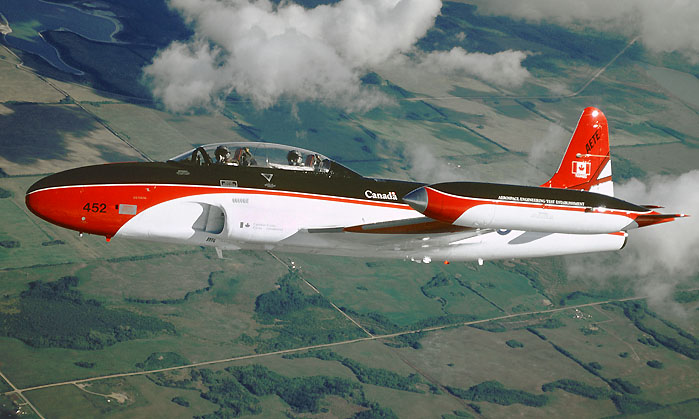
Time will tell if the –forced- withdrawal of the CT-133’s will enable AETE to successfully develop and test fourth generation ejection seats and survival equipment. The information (data and video-coverage) gathered by these ‘first generation aircraft’ safeguarded without any doubt further generations of operational pilots……not even been born when these four 1950’s-era -out of 656- CT-133’s were built….
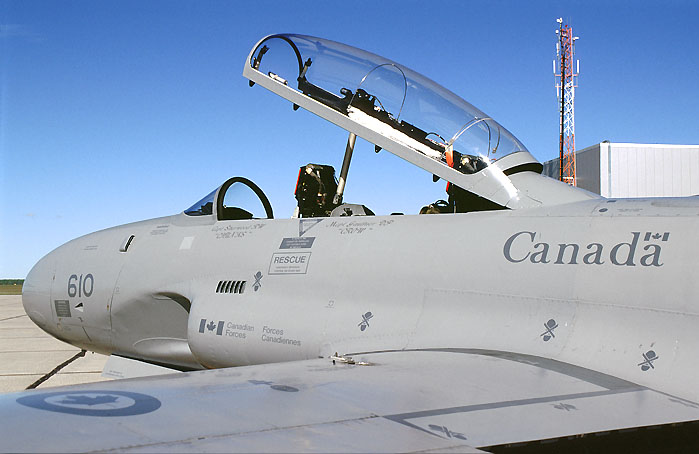
© Stefan DEGRAEF / Edwin BORREMANS
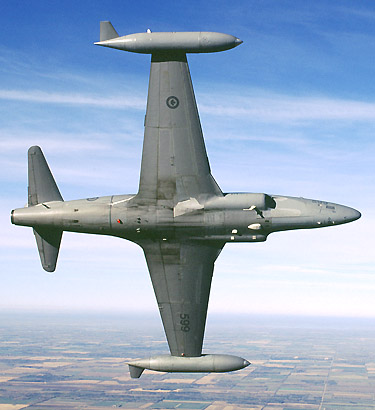
ARTICLE PUBLISHED IN :
-
AIR FORCES MONTHLY (UK)
-
AIR INTERNATIONAL (UK)
-
INTERNATIONAL AIR POWER REVIEW (UK)
-
LETECTVI (Czech Republic)
-
JET & PROP EXTRA (Germany)
-
SIIVET (Finland)
-
FUERZA AEREA (Spain)
-
KOKU FAN (Japan)
-
JWINGS (Japan)
-
AIRNEWS (Japan)
-
ALAS (Argentina)
-
ASAS (Brazil)
-
ARANYSAS (Hungary)
-
PTISI (Greece)
-
LOTNICTWO (Poland)
-
WIRAZE (Poland)
-
AEROMAGAZIN (Serbia)
-
AIR CLASSICS (United States of America)
-
FLIGHTLINE (United States of America)
-
READ MORE: RCAF 425 SQ CF18 |